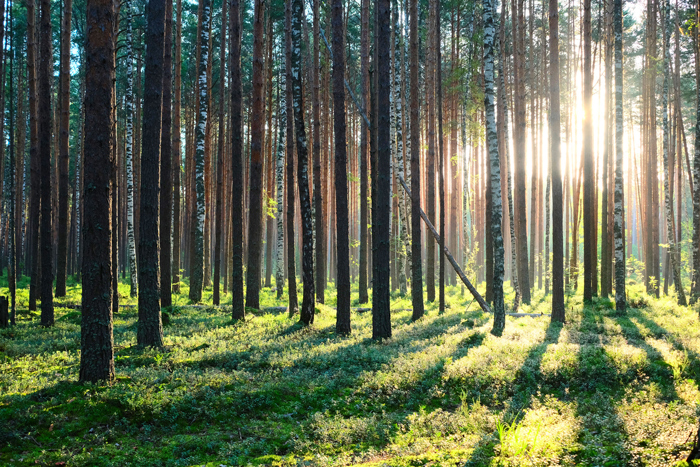Keeping Our Forests Healthy: Strategies That Are Working |
|||||
|
|||||
The biggest threats to our forests and broader ecosystem are development and climate change with their partners in crime, air pollution and invasive plants and pests. So, what can we do as a state and as individuals and communities to preserve and protect our forests and wildlife habitat? Phil Huffman is the director of Landscape Conservation and Policy for The Nature Conservancy’s Vermont office. He heads up TNC’s large-scale forest conservation and sustaining corridors and forest integrity initiatives involving many collaborative partnerships. Over the past 55 years, TNC has helped conserve about 300,000 acres in Vermont. As aging forestland owners pass on their holdings, the risks associated with subdivision increases parcelization or fragmentation of the forests. TNC is trying to assist landowners to think about the future of Vermont’s forests. Huffman believes climate change is the “defining issue of our time. How do we figure out, while we still have time, how to live on the land with other species in a way that will sustain the integrity of the landscape?” One of the projects TNC is tackling is to create and sustain forested corridors for wildlife movement. In an effort to maintain landscape connectivity, TNC is partnering with the Vermont Fish and Wildlife Department and the Vermont Agency of Transportation to identify high-priority wildlife crossings and create safe crossings to protect both animals and drivers. “We’re working with landowners to voluntarily conserve key parcels that help maintain forested ‘stepping stones’ and pathways. And we’re working with towns and regional planning commissions to incorporate connectivity into land use plans and policies,” he says On a broader scale, the Vermont Agency of Natural Resources (ANR) is a partner in a national initiative called Staying Connected (http://stayingconnectedinitiative.org/assets/Northern_Apps_-Staying-Connected_Project_Overview_FINAL.pdf), funded through the US Fish and Wildlife Service. It’s designed to restore wildlife and landscape connections across the entire northern forest area. Seven priority areas are identified, five of which include sections of Vermont. As part of the northern Appalachians region, also called the Northern Forest, Vermont is right in the middle of one of the largest, intact temperate forests in the world, spanning from New York state east to Vermont, New Hampshire, and northern Maine and across the border into Quebec and the Maritime provinces. The Northern Forest is home to many at-risk species, rare alpine vegetation, large blocks of unfragmented forests (like Vermont’s Champion Lands), wide-ranging animal species like the black bear and Canada lynx, and over five million people. Analysis conducted by Two Countries, One Forest, an international collaborative, highlights the risks that this vast forest will become “separated into a series of disconnected ecological islands—isolating wildlife populations and limiting their ability to migrate and adapt in response to a changing climate.” This makes landscape connectivity here all the more critical because Vermont is the linchpin connecting the whole region. One of the five priority areas identified “as critical in maintaining the integrity of the entire Northern Forest region” is in Franklin County where Nancy Patch is the county forester. A 30-year veteran forester, Patch is helping lead a partnership called Cold Hollow Woodlots: Connecting Landowners Across the Landscape, looking at long-term conservation (Cold Hollow Climate Change Response Framework, www.forestadaptation.org/ColdHollow). The idea was to find 10 to 12 landowners with contiguous properties and bring them together to look at forest management as a group. Each has at least 100 acres and collectively own over 2,000 acres. The long-term goal is to permanently conserve 30 percent of the large blocks in the region. The project, located in Enosburg, works with each landowner to design his or her own forest management plan, then share broader goals focusing on wildlife and biodiversity. This is a neighbor-to-neighbor approach, time consuming but effective. Patch claims that “you can’t get too big. It has to be a neighborhood to be successful. People who had never talked about climate change now talk about it.” They host potlucks and meet on each others’ properties. Using a landscape analysis, the landowners are now well versed on the benefits of sustainable forest management to create healthy forests that will be more resilient to climate change stressors. “The most successful part is when people see they can make a difference. Talking about forest bird habitat overlaps with forest health in general and that leads to talking about climate change. It goes from despair to hope,” says Patch. Patch acknowledges there is dramatic change coming, but we can prepare for it. To maintain species diversity, we can help forests respond by supporting natural forest dynamics. “Nature loves complexity and humans like things ordered, so that’s how we look at forests,” she says. “A healthy forest is one you can’t see a far distance into. It’s not the maple stand with ferns covering the ground. Ferns are there because the soil is compacted and that keeps the forest from regenerating.” The Cold Hollow Woodlots are part of the regional conservation partnership, Cold Hollow to Canada, that connects it to seven other towns on the western edge of the Green Mountains. In addition to the ANR’s Department of Forests, Parks and Recreation, other partners include the North Woods Forestry Consulting and Vermont Audubon. By 2030, it is estimated that Vermont will have an additional 85,000 residents compared to the 2013 population. This growth could be even greater, depending upon whether there is a migration from areas experiencing the adverse effects of climate change. Meanwhile, Vermont is experiencing more frequent wind and ice storms that are killing off certain tree species that can’t regenerate easily. Invasive species are exploding across the landscape, and development sprawl is eating up huge tracts of land. Patch explains that each home built in the woods affects a surrounding 35 acres. “We have to concentrate our growth and be really smart about where we put our footprint so we’ll have something left.” |
|||||
 |
|||||
|
Sandy Wilmot, forest health specialist and climate change coordinator in the Department of Forest, Parks and Recreation, believes that engaging and educating communities is key and cites progress working with landowners and the Vermont Woodlands Association around “sound management practices concerning wildlife, water, wood, and recreation.” She holds workshops around the state so that landowners interested in conservation can be identified and educated on how to maintain healthy forests. Wilmot believes different communication strategies are needed to reach different audiences, easing into uncomfortable topics, so people can be informed and educated without shutting down. She works with topics people feel strongly about, like being prepared, planning for ways to be safer, and caring for family members and animals. Matt Langlais is the Essex-Caledonia County forester. He feels we often take for granted the recreational benefits forests provide for our tourist economy, an economy that generates almost a quarter of our state employment. Thoughtful forest management can harvest reciprocal ecological and economic benefits. And, if you can help people think about where their heating wood and food comes from, Langlais is confident that they will be more likely to make economic decisions based on what’s best for their local community. The Vermont Working Lands Enterprise Initiative, launched in the 2012 legislative session, is a small but crucial first step in preserving and growing our working landscape by investing in agricultural and forestry-based businesses. A major focus is helping families transition from working the land to retirement, while keeping that land intact with the next generation of owners. Langlais helps owners who have depended on a diminishing market for forest products, like pulp, move into new forest-based businesses, like producing chips for pellets. The recreational aspects of forests are also mushrooming in parts of the Northeast Kingdom. Langlais describes the benefits of the Kingdom Trails as a win-win for both the ecology and economy. A dozen new businesses have opened up in the East Burke area as mountain biking has become a more and more popular outdoor sport, generating millions of dollars in business for the local community. Langlais believes the state could do more to encourage this kind of land use. Currently landowners who donate their lands to these popular mountain biking trails receive nothing for their contribution. The state could compensate or provide incentives for this instead of taxing the land on the basis of its development potential. At The Nature Conservancy, Huffman is also concerned about Vermont’s water quality and the relationship of protecting and restoring wetlands and forests as part of the solution. Stepping back to see the big picture, Huffman, like Langlais, doesn’t see a conflict between ecological and economic interests. “Our economy depends on the natural world and it depends on humans. There may be places that are so special ecologically that the right thing to do may be to leave them alone,” he says. As our global fossil fuel extraction increases, the capacity of our forests to absorb CO2 becomes more important. The tiny country of Bhutan in the Himalayas is proof of how important forests are. With a population just slightly greater than Vermont’s, it has become the first carbon negative country in the world. Its forests absorb more carbon dioxide (about 6 million tons) than it produces (2.2 million tons), the result of strong environmental policies and government investment. Seventy-two percent of Bhutan is forested, less than Vermont’s 75 percent. According to the ANR’s report Adapting Forests to Climate Change, our contiguous northeast forests are one of the “largest available land-based sinks for atmospheric carbon” remaining and offset a significant portion of heat-trapping carbon dioxide emissions that would otherwise contribute to climate change. Vermont’s forests are estimated to sequester over eight million metric tons of CO2 equivalents (MMTCO2e) per year, almost as much as our annual emissions. We could become the US equivalent to Bhutan. “I feel like education is really key to keeping our natural resources,” offers Wilmot. “The more people understand how they’re connected to the forests, the more they’ll be engaged in what happens to them. I would encourage people to stay current. Try to understand what is going on at the local level and how local planning is influencing natural resources. It sounds simple, but it is really the most powerful thing we can do.” Talk to your regional planning commissions, your town conservation committees, and your neighbors about how to preserve the forest ecology you care about and how to manage growth in ways that will keep our forests and wildlife habitats healthy and thriving. Put grassroots pressure on your legislators to make this a priority at the State House. |
|||||
| K.C. Whiteley is a climate change activist and serves on the 350VT advisory board.
|
|||||

